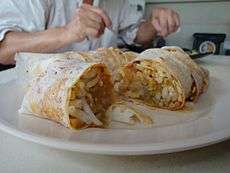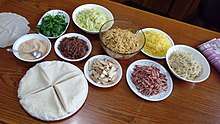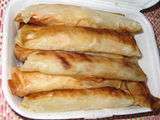Popiah
Popiah (Pe̍h-ōe-jī: po̍h-piáⁿ) is a Fujianese/Teochew-style fresh spring roll. Popiah is often eaten in the Fujian province of China (usually in Xiamen) and its neighbouring Chaoshan (and by the Teochew and Hoklo diaspora in various regions throughout Southeast Asia) and in Taiwan (due to the heavy Hokkien influence), during the Qingming Festival. The origin of popiah dates back to the 17th century.[1][2]
 Closeup of a popiah roll with a filling of bean sprouts and other ingredients | |
| Alternative names | Baobing, Runbing, Bopijuan |
|---|---|
| Place of origin | Fujian, China |
| Region or state | East Asia (Teochew and Hokkien-speaking communities), Southeast Asia |
| Associated national cuisine | Singapore, Indonesia, Malaysia, China, Taiwan, Thailand, Vietnam, Myanmar |
| Main ingredients | Popiah skin, bean sauce, filling of finely grated and steamed or stir-fried turnip, jicama, bean sprouts, French beans, lettuce leaves, grated carrots, Chinese sausage slices, thinly sliced fried tofu, chopped peanuts or peanut powder, fried shallots, and shredded omelette |
| Variations | Lumpia, bò bía |
| Other information | Eaten during Qingming Festival |
| Popiah | |||||||||||
|---|---|---|---|---|---|---|---|---|---|---|---|
| Traditional Chinese | 薄餅 | ||||||||||
| Simplified Chinese | 薄饼 | ||||||||||
| Hokkien POJ | po̍h-piáⁿ | ||||||||||
| |||||||||||
| Alternative Chinese name | |||||||||||
| Chinese | 潤餅 | ||||||||||
| Hokkien POJ | jūn-piáⁿ or lūn-piáⁿ | ||||||||||
| |||||||||||
Etymology
In the Chaoshan dialect, popiah is pronounced as /poʔ˩piã˥˧/ (薄餅),[3] which means "thin wafer". In varieties of Hokkien, it is also commonly referred to as /lun˩piã˥˧/ (潤餅), which is the etymological origin of "lumpia" in Indonesia and the Philippines. It is referred to as rùnbǐng (潤餅) or báobǐng (薄餅) in Mandarin, and also as bópíjuǎn (薄皮卷).
Wrapper and fillings
A popiah "skin" (薄餅皮) is a soft, thin paper-like crepe or pancake made from wheat flour. The method of producing the wrapper involves making an extremely wet and viscous dough. A ball of this dough is held to the right hand, then quickly "rubbed" (擦潤餅皮, Hokkien: chhat jūn-piáⁿ phê, literally "to rub a lumpia crepe") against a hot steel plate in a circular fashion, and lifted.[4][5] Through this process, a very thin layer of the wet dough adheres to the plate and begins to cook. The upper surface of the crepe is then usually cleaned of excess pieces of dough using the dough ball through a dabbing process.[5] When the dough has been cooked to completion, it is peeled off of the hot steel plate before being removed. The rubbing is typically done over two or three plates at once, which allows the baker to continuously produce crepes and gives the proper time for each crepe to be properly cooked.[6]
It is eaten in accompaniment with a sweet sauce (often a bean sauce), a blended soy sauce or hoisin sauce or a shrimp paste sauce (hae-ko, Pe̍h-ōe-jī: hê-ko), and optionally with hot chilli sauce before it is filled. The filling is mainly finely grated and steamed or stir-fried turnip, jicama (known locally as bangkuang), which has been cooked with a combination of other ingredients such as bean sprouts, French beans, and lettuce leaves, depending on the individual vendor, along with grated carrots, slices of Chinese sausage, thinly sliced fried tofu, chopped peanuts or peanut powder, fried shallots, and shredded omelette. Other common variations of popiah include pork (lightly seasoned and stir-fried), shrimp or crab meat. Seaweed is often included in the Xiamen versions. Some hawkers in Malaysia and Singapore, especially in non-halal settings, will add fried pork lard. As a fresh spring roll, the popiah skin itself is not fried.
Two common ways of eating this are holding them like a burrito, which some prefer, while others cut the popiah roll into slices and pick them up with chopsticks.
Types
In mainland China, Taiwan, Singapore and Malaysia there are "popiah parties" at home, where the ingredients are laid out and guests make their own popiah with proportions ingredients to their own personal liking.
Taiwanese

In Taiwan, popiah is called runbing (潤餅) in Mandarin (jūn-piánn(-kauh) in Taiwanese Hokkien).
The stuffing itself is quite diverse among different places. The basic stuffing includes vegetables that grow in spring, meat and thinly shredded omelette. In some places, they also add noodles, Chinese sausages, stewed vegetables instead of blanched ones, tofu, seafood, sticky rice, and so on.
Furthermore, the way of cooking the stuffing is very different as well. In northern Taiwan, the stuffing is flavoured, stir-fired, sometimes it goes with peanut powder, and the sauce is salty. In southern Taiwan, the popiah stuffing is water blanched without additional seasoning, and flavoured primarily with sugar and peanut powder. For people who live in southern Taiwan, the addition of sufficient sugar is key for popiah. Moreover, some people like to heat or steam the spring roll again after it is made.
Southeast Asia
In Malaysia and Singapore, popiah is part of Chinese cuisine of these two countries. However, in both countries, as well as in Brunei, popiah especially the fried variant is also popular as part of local street food. In Vietnam, bò bía is the Vietnamese variant of popiah, introduced by Teochew immigrants. It is common to see an old Teochew man or woman selling bò bía at their roadside stand. In Thai cuisine, two types of popia (Thai: เปาะเปี๊ยะ) are popular: popia sot (fresh spring roll) and popia thot (deep-fried spring roll). In addition, Thai cuisine has also incorporated the Vietnamese summer roll under the name kuaitiao lui suan (Thai: ก๋วยเตี๋ยวลุยสวน). While in Burma/Myanmar, it is known as kawpyan (ကော်ပြန့်). Similar foods in other cuisines include the Indonesian Lumpia Basah and the Filipino lumpiang sariwa spring rolls which are served with peanut sauce, etymologically derived from the Hokkien name Lum Pia. Majority of ethnic Chinese in both countries are of Hokkien origin.
 Fried popiah being sold in Malaysia
Fried popiah being sold in Malaysia Hot and spicy fried popiah, popular in Malaysia. On the left is coated with heavy chili sauce.
Hot and spicy fried popiah, popular in Malaysia. On the left is coated with heavy chili sauce. Sweet "Bò bía" sold at a street vendor in Hanoi, Vietnam
Sweet "Bò bía" sold at a street vendor in Hanoi, Vietnam
References
- "照過來!清明到呷潤餅" [Picture it! Qingming Festival to lunpia]. TVBS (in Chinese). 31 March 2017. Retrieved 24 May 2020.
- "清明吃润饼你知道来历吗? 美味润饼菜咋做?" [Do you know the origin of Qingming eating lunpia?]. 闽南网 (Minnan Net) (in Chinese). 1 April 2016. Retrieved 24 May 2020.
- Wu, Olivia (10 January 2011). "Full-moon feast". The San Francisco Chronicle.
- Mowe, Rosalind (2008), Culinaria Southeast Asia: A Journey Through Singapore, Malaysia and Indonesia, Ullmann, ISBN 978-0-8416-0370-7
- 5 潤餅皮拿起來的姿勢 (七分鐘).wmv, eva354520 Description: A beginner learning the proper techniques and tricks of how to "rub" a popiah crepe.
- 羅東夜市潤餅皮製作, ych12001
External links
| Wikimedia Commons has media related to Popiah. |
